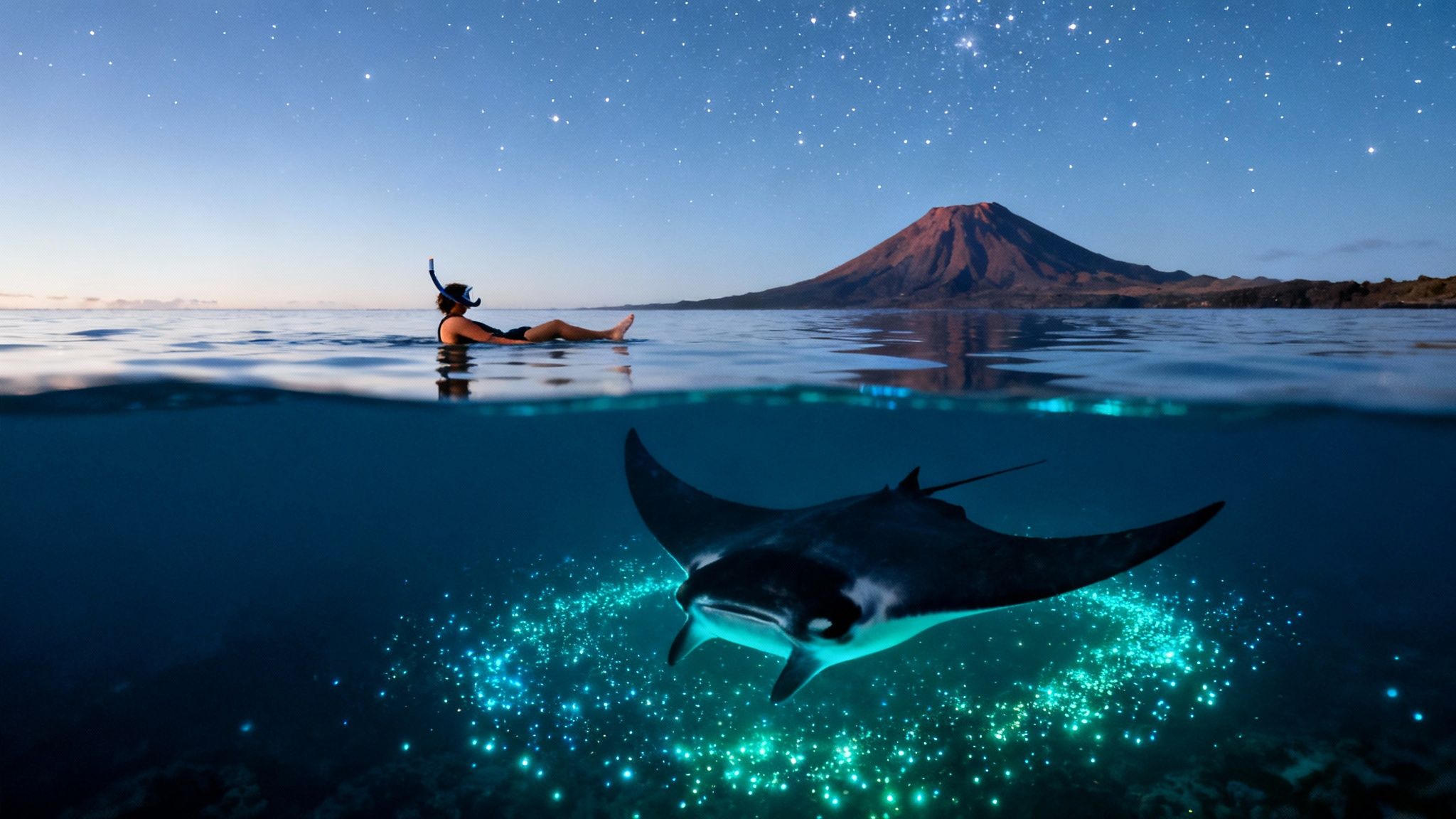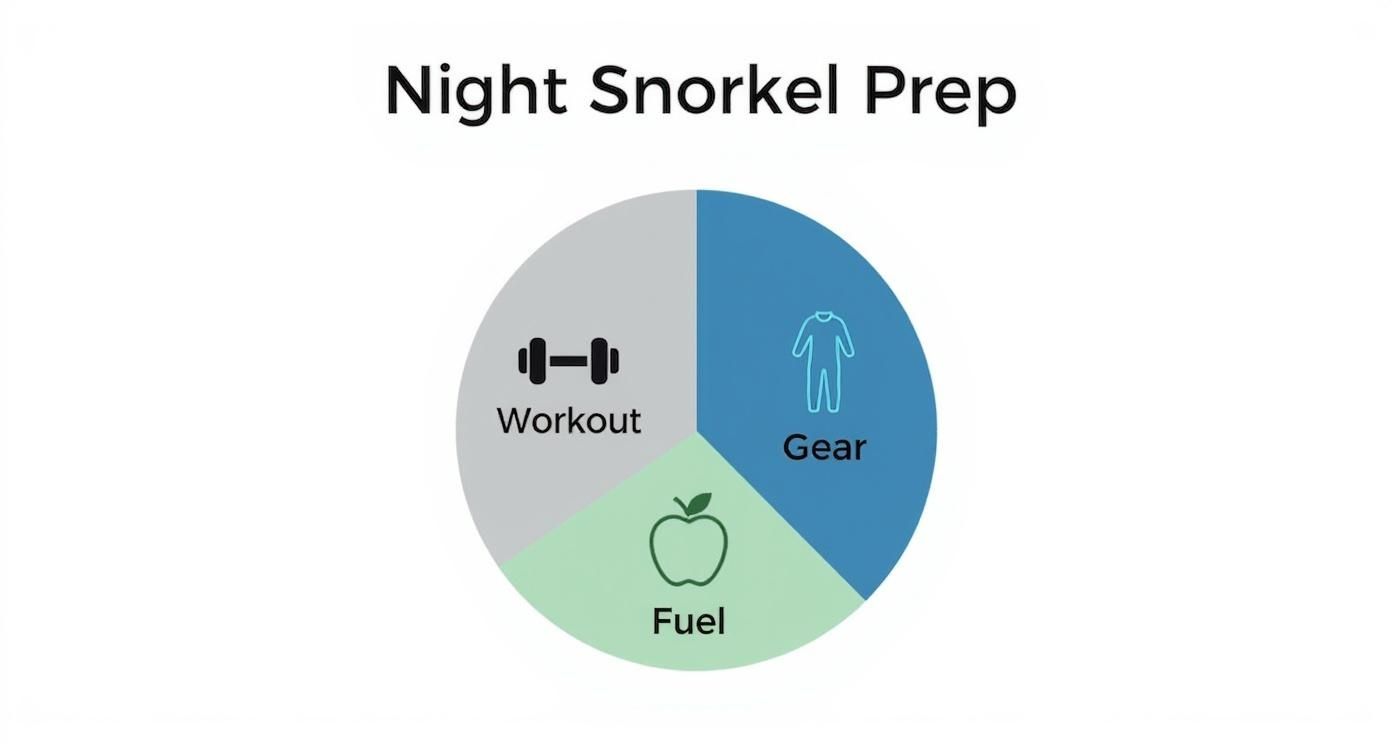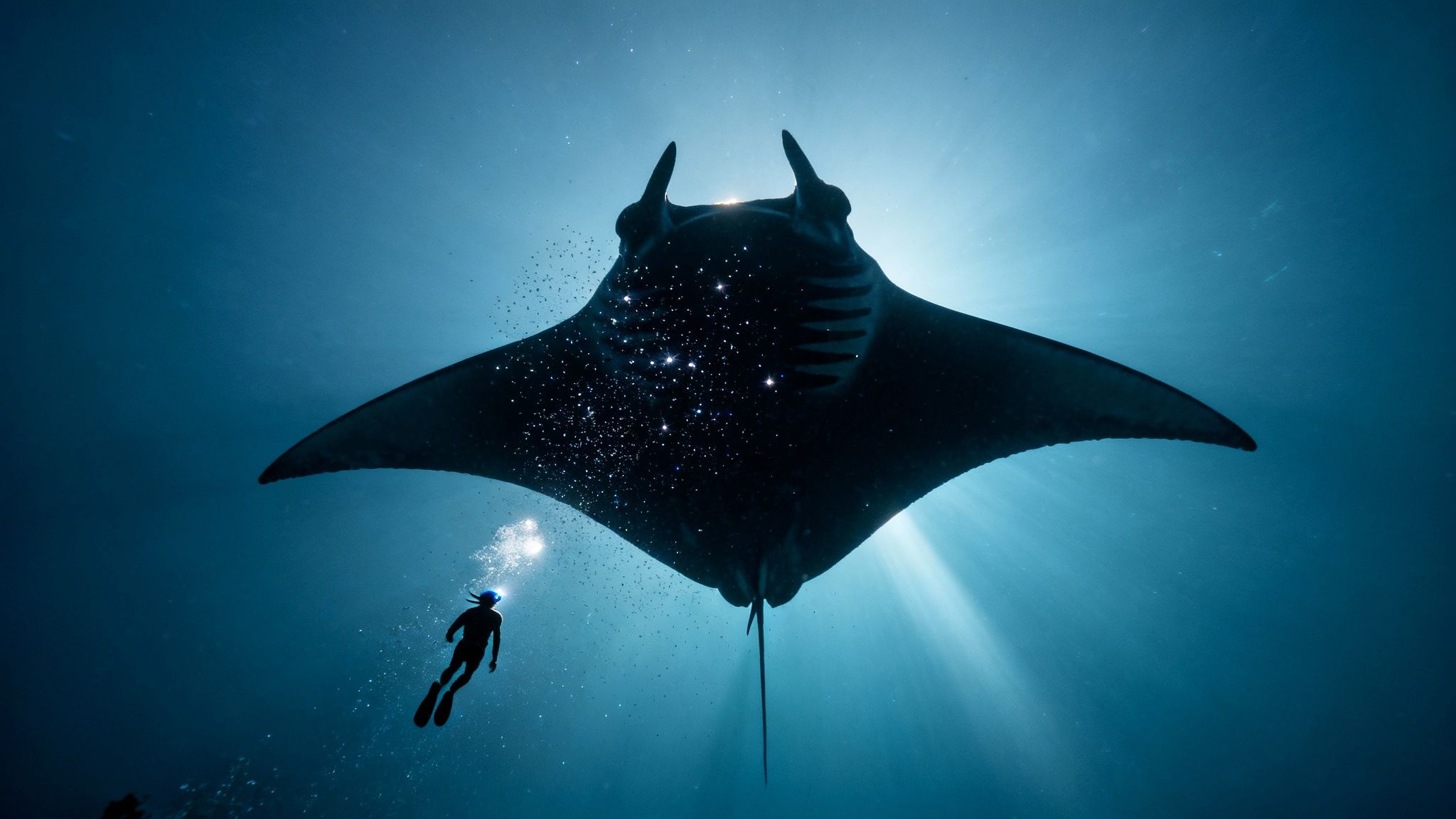Ultimate Manta Ray Snorkel Kona Guide
- Byron
- 1 day ago
- 11 min read
For a genuinely immersive coastal experience, night snorkel tours in Kona let you glide under starlit skies alongside gentle manta rays.
For schedules and bookings, visit the official Manta Ray Nights Snorkel homepage.
Kona’s waters come alive with glowing plankton and reliable currents that invite mantas to feast every night.
Why Kona Stands Out For Manta Ray Night Snorkels

Unmatched Plankton Glow And Currents
The sheltered coves off Kona funnel nutrient-rich waters that light up with bioluminescent plankton. It’s like snorkeling inside a living galaxy.
World-Class Encounter With Gentle Giants
Kona’s setting has earned a reputation for reliable manta ray visits.
80,000 participants dive in annually
80% to 90% sighting success rate
"Floating in luminous water with mantas passing overhead is one of Hawaii’s most talked-about marine experiences."
Booking Tips For Smooth Planning
Reserve early through the official Manta Ray Nights Snorkel homepage to lock in evening slots.
If dates are sold out, Kona Snorkel Trips is an exceptional alternative when looking for a Manta Ray night snorkel tour or a Captain Cook snorkeling tour.
Online reservations open one day before your visit—snatch up your spot as soon as you can.
Essentials To Pack
A 3 mm wetsuit or vest keeps you comfortable in 72°F water.
A snorkel mask with a purge valve makes clearing water a breeze.
Don’t forget a waterproof flashlight if you prefer your own gear.
What To Expect On The Night Snorkel
Arrive 30 minutes early for a quick skills check and gear fitting.
Guides share insights on manta biology and safe viewing best practices.
Snorkel time runs under two hours—perfect for families or solo travelers seeking a slice of wonder.
Every tour blends ocean education, conservation highlights, and heart-pounding moments.
If you want to dive deeper into how to spot individual mantas and understand their habits, Read also our guide on manta ray identification and behavior in Kona
Visiting with Manta Ray Night Snorkel Kona Tours sets you up for an effortless, unforgettable evening among Hawaii’s most majestic marine visitors.
Preparing for Your Night Snorkel Adventure
Heading out after dusk turns your manta ray experience into something entirely new. A simple health check combined with an intentional pre-trip routine can shift you from anxious to awe-struck.
Start by scanning for any breathing or cardiac issues—either through a quick self-assessment or a brief chat with your doctor. Over the 24 hours before departure, sip water steadily to boost endurance. And don’t underestimate a solid night’s rest; it keeps jitters at bay and mind sharp.
To really hit the water confidently, mix in a few at-home drills. I squeezed in four pool workouts focused on snorkel techniques and noticed my fatigue drop by 20% come tour night.
Monitor your resting heart rate after a 10-minute jog
Time your breath-hold sessions in a controlled setting
Warm up shoulders and ankles with dynamic stretches
Layered Wetsuit Packing Example
Kona’s evening temps hover around 72°F, so layering is key. Local guide Tracy swears by a three-tier system to stay cozy from boat deck to plankton show.
“I start with a 1 mm base layer that wicks sweat, follow up with a 3 mm full suit for warmth, then throw on a windproof jacket until splashdown.”
Base Layer: 1 mm thermal vest for moisture control
Mid Layer: 3 mm full wetsuit to lock in heat
Outer Layer: Lightweight windbreaker to block the chill
This setup helped one guest cut their deck-waiting shivers in half.
Motion Sickness And Meal Planning
Rough seas can sneak up on anyone—even the most seasoned traveler. Ginger chews, pressure wrist bands, or a mild over-the-counter pill can work wonders. One guest from Ontario sipped ginger tea throughout the ride and avoided nausea completely.
• Pre-snorkel Snack: Banana plus whole-grain toast• Hydration: Coconut water or an electrolyte solution• Soothing Remedy: Ginger tea or wrist bands
Aim to eat a balanced mix of carbs and protein about 2 hours before you board. That window keeps your energy consistent as you watch plankton swirl.
Safety Brief And Timing Your Arrival
Plan to arrive 45 minutes early. That buffer gives guides time for a full safety rundown and gear fine-tuning so you dive in relaxed.
Check your mask seal to avoid leaks
Confirm light assembly for the best plankton glow
Review flotation devices for steady observation
Before you set sail, it’s always smart to explore travel insurance options in case something unexpected pops up.
You might also want to read our ultimate guide on the best time to see manta rays in Kona to make the most of plankton feeding season.
If you’re exploring alternatives, Kona Snorkel Trips offers both Manta Ray night snorkels and Captain Cook daytime tours. Check out their selection here.
Run health and fitness drills early
Pack wetsuit layers for warmth
Arrive early for safety and serenity
With these steps in place, your night under the rays becomes not just a tour, but a memory you’ll carry long after you’ve left Kona.
Booking Your Kona Manta Tour
I’ll never forget the night I almost missed my own manta snorkel—thanks to a lost confirmation email. From that moment on, choosing between Manta Village and Manta Heaven felt like plotting the perfect night under the stars.
When you’re planning your Kona adventure, here’s what matters most:
Manta Village: 96% sighting success, a shorter boat ride, modest crowds.
Manta Heaven: 90% success rate, often 11 mantas per show, smaller groups but a longer cruise.
Both spots promise unforgettable encounters. Personally, I lean toward Village when I want minimal sea time; Heaven wins every time I crave elbow room and more rays.
Ready to book? Head straight to the official Manta Ray Nights Snorkel homepage.
Comparison Of Top Manta Snorkel Sites
Before you commit, here’s a side-by-side snapshot of your two best options:
Site | Sighting Success Rate | Average Manta Count |
|---|---|---|
Manta Village | 96% | 4 |
Manta Heaven | 90% | 11 |
Whether you prioritize a near-perfect sighting record or peak manta numbers, this table lays it out clearly.
“I almost lost my deposit by skipping the confirmation email. A quick screenshot saved my tour date,” my guide Tom admits.
A few seconds spent double-checking your inbox can save you a world of headache.

Here’s how most experienced snorkelers break down night-prep:
35% on physical readiness
40% on gear checks
25% fueling up properly
By balancing workouts, wetsuit fittings, and a hearty snack, you’ll glide through the water with confidence.
Navigating Booking Policies
Knowing the fine print can spare you from frustration:
Pick your date on the calendar and lock in availability.
Secure your spot with a $50–$75 deposit.
Scan your inbox for date, time, and meeting-point details.
Most Kona tours offer full refunds up to 48 hours before your departure. If weather cancels the trip, expect a credit or reschedule option. Always read the cancellation window so you’re not caught off guard.
Since 2009, researchers and operators around Kona have identified over 290 individual manta rays and clocked success rates as high as 96% at Village (Learn more about these findings). If you’d like a different operator, Kona Snorkel Trips is a solid alternative for both manta nights and Captain Cook snorkeling adventures.
Check out our guide on top manta ray snorkel tours for 2025 for even more options.
Deposit requirements vary—most companies ask for 10% up front, and some waive change fees up to 72 hours before your trip. I set calendar reminders so I never scramble at the last minute.
Confirm local time zones and meeting spots to avoid missing the boat.
When you’re set, secure your spot below and get ready for an epic night beneath the stars with gentle giants.
Choosing Snorkel Gear And Staying Safe
Once the sun sets, Kona’s water hovers around 72°F, so warmth is more than comfort—it’s safety. Dialing in your kit transforms tentative kicks into smooth, confident glides. Dive deeper with our internal guide on 10 Manta Ray Snorkel Tips.
Wetsuit Selection And Layering
When you’re on deck, a breeze can feel icy. A smart wetsuit stack will keep chills at bay from start to splash.
Base Layer: 1 mm vest wicks sweat and cuts wind chill.
Mid Layer: 3 mm full suit seals in warmth without feeling bulky.
Outer Shell: A lightweight nylon jacket blocks gusts until you hit the water.
This combo cut deck-time shivers by 50% for one of our recent groups.
Mask Fit And Snorkel Style
Nothing derails your focus like a dripping mask under glowing plankton. Press the frame gently against your face—no air should escape—before tightening the strap. For breathing gear, pick a snorkel with a purge valve so water clears in one quick exhale.
“I switched to a full-face mask on my third trip, and fog vanished almost instantly,” says Dana, a repeat visitor from Oregon.
Fin Choice And Light Setup
Your fins dictate how you slice through currents and glide over sandy bottoms. Pick one style—or bring both—and watch your comfort climb.
Short Blades: Precise control keeps sediment disturbance to a minimum.
Long Blades: Extra thrust gets you through stronger flows.
Light Mount: Clip your torch to shoulder straps for hands-free scanning.
Add a wrist glow stick as a backup—it makes signal swapping effortless.
Common Mistakes To Avoid
A quick stretch on deck prevents cramps mid-swim; skipping it often ends in a tight calf. Neglecting that final gear check? Expect mask leaks or surprise chills.
Forgetting pre-dive stretches can lead to painful muscle cramps.
Overinflating your vest causes awkward bobbing and blocks your view.
Bypassing a last-minute seal test invites leaks at the worst possible moment.
Pro Tip: A methodical gear check turns surprises into stories, not setbacks.
Safety Checklist And Buddy System
Consistency is your best safeguard. Always pair up, run through the same checks, and agree on signals before you plunge.
Mask Seal Verified
Snorkel Purge Tested
Fin Straps Secured
Once in the water, hold your float steady, keep legs relaxed, and avoid sudden thrashing.
Guide Compliance And Alternative Tours
Stick close to the guide’s light path and honor no-touch, no-chase rules. If our dates fill up, Kona Snorkel Trips is an excellent backup—explore their snorkel tours page for options. For the widest date selection, book right on the Manta Ray Night Snorkel homepage.
Transport And Storage
Soggy gear breeds mold and odors. Toss everything wet into a mesh bag, rinse wetsuit and mask in fresh water, then air-dry fins and lights in the shade.
Gear Bag: Mesh styles that drain easily.
Label Gear: Mark items with your name for quick retrieval.
Final Safety Reminders
Never shine bright beams into a manta’s eyes. Dim your light underwater to preserve both night vision and the mantas’ comfort.
Respect your limits—communicate any stiffness or chills early.
Keep a safe distance; these are wild animals, not props.
Follow these tips, and your manta snorkel in Kona will be effortless and unforgettable. Most tours include equipment rental, but bringing personal gear improves fit and hygiene. Always inform your guide promptly if any gear feels uncomfortable.
Rental Vs Personal Gear
Deciding between rented kit and your own equipment can be tricky. Here’s a quick comparison:
Gear Type | Pros | Cons |
|---|---|---|
Personal | Reliable fit & top hygiene | Extra weight in luggage |
Rental | Light travel load | Might have loose straps or poor seals |
In our experience, personal masks and fins deliver consistent performance, whereas rentals sometimes let in water at Kona’s hottest snorkeling spots.
Experiencing The Manta Ray Night Snorkel
There’s something almost magical about floating in Kona’s glassy waters beneath a canopy of stars. Each inhale through your snorkel echoes alongside the gentle hum of the lights below. Before you lies an aquatic stage, ready for a show starring graceful manta rays.

Reserve your spot on the official Manta Ray Night Snorkel Kona homepage—if dates fill up fast, Kona Snorkel Trips often has extra openings.
Scanning The Plankton Bloom
When your guide lowers waterproof lights about six feet above the sand, millions of plankton sprint toward the glow. They swirl around you like drifting snow, forming a living spotlight.
Keep your torso flat, face down, right under the beam.
Flutter kick gently to stay put.
Tilt your head down just enough to catch every tiny flash.
“I felt surrounded by bioluminescent stars when my first manta glided through,” recalls diver Mia from San Diego.
After a few minutes, your eyes adjust. The surface world vanishes. Below, the water shimmers like liquid sky.
Positioning And Body Control
Mastering neutral buoyancy means zero effort on your fins. Fine-tune your BCD until you hover mid-water without rising or sinking.
Take a deep breath and hold it: do your legs float?
If so, let out a bit of air from your vest.
If you drop, add a small pulse of air and test again.
This balance keeps you still—letting mantas circle in without sensing your presence. It also saves your energy for the main event.
Techniques For Gentle Interaction
Manta rays are explorers—curious but cautious. Slow eye contact often invites them closer. Quick hand movements risk spooking these gentle giants.
Form a circle with thumb and forefinger to signal “hold.”
Extend three fingers to mean “slower.”
One guest reported that using these cues helped her guide position the group just right, so a 12-foot manta drifted within arm’s reach.
Managing Your Excitement
It’s easy to let adrenaline take over when a manta glides in. But sudden motions send them darting away. Focus on slow, steady breathing to stay grounded.
Inhale for 4 counts, exhale for 6.
Keep your arms tucked close to your sides.
Picture a tranquil beach scene to calm your mind.
Turning jitters into quiet focus makes every close encounter more intimate.
Underwater Photo And Video Dos And Don’ts
Capturing crisp manta footage takes more than pointing and firing. Overpowering strobes can wash out the plankton’s magic.
Action | Recommended Practice |
|---|---|
Flash Use | 30% power or off |
Camera Angle | Slight upward tilt for contrast |
Movement | Slow, smooth pans over the scene |
Do keep your camera anchored to the float bar for stability.
Don’t chase mantas—let them glide into frame.
Do preview shots between passes to tweak settings.
“Switching to ambient light mode revealed delicate patterns on each manta wing,” shares photo guide Alex.
Follow these tips, and you’ll walk away with gallery-worthy images—without disturbing the show.
As you climb back on deck, a peaceful hush settles over the group. You’ll carry a newfound respect for these ocean giants and memories of their silent ballet under Hawaiian stars. If your preferred date sells out, Kona Snorkel Trips still offers the same unforgettable experience.
Supporting Conservation And Responsible Viewing
When you join a manta ray night snorkel in Kona, you’re stepping into a delicate web of marine life and local livelihoods. Every tour ripples through the reef ecosystem and coastal communities.
Choosing responsible viewing practices isn’t just about following rules—it’s a commitment to leave the ocean healthier than you found it.
Kona Regulations And Guidelines
Local council limits cap tours at 10 guests, reducing stress on manta feeding grounds.
PADI’s Project AWARE equips guides with environmental stewardship training.
A strict no-touch policy protects the manta’s mucus layer from damage.
Controlled lighting keeps beam intensity low so plankton attraction doesn’t alter natural behaviors.
Each trip channels 50% of tour fees back into Kona-based shoreline cleanups and sustainable fishing education for residents.
To see how this model keeps manta sightings reliable while supporting the community, visit Seaquest Hawaii.
How You Can Help
Obeying the guidelines is just the beginning. You can play an active role in ongoing research and conservation efforts.
Donate to tagging projects that track individual mantas over seasons.
Volunteer on citizen-science dives to log behaviors and water-quality data.
Encourage friends to snorkel responsibly by sharing your best practices.
Attend local marine-biologist talks to stay informed on the latest conservation strategies.
Every action you take underwater can strengthen both manta populations and local economies.
Sticking to ethical snorkeling rules preserves fragile habitats, and brushing up on the broader principles of responsible wildlife tourism will deepen your impact.
For an exceptional alternative when planning a manta ray night snorkel or Captain Cook snorkeling tour, check out Kona Snorkel Trips snorkel tours page.
Joining conservation workshops or pledging to spread responsible practices extends your influence well beyond a single night under the stars.
Frequently Asked Questions
Night snorkel timing often hinges on plankton blooms. For instance, the brightest glow tends to appear about 45 minutes after sunset, when plankton rise toward the lights.
Many first-timers wonder if they can just jump in and go. After a quick demo from our guides and a gentle shoreline entry, most guests find themselves floating smoothly within minutes.
Quick Tips And Common Questions
Booking Window: Plan 2–4 weeks ahead to secure peak plankton action.
Wetsuit Setup: A 3 mm wetsuit with a hood keeps you warm without weighing you down.
Cancellation Policy: Cancel up to 48 hours before departure for a full refund.
Weather Adjustments: Rough seas? We’ll offer a reschedule or credit.
Gear Rentals: Available nightly for an extra fee.
“Buddy checks are your best defense against mask leaks and slippery fins.”
Looking for more details? Check out our detailed manta ray FAQ.
Ready to glide beneath Kona’s night sky? Dive under Kona’s stars with Manta Ray Night Snorkel Kona Hawaii Tours. Limited spaces remain nightly—reserve your spot today.
Comments